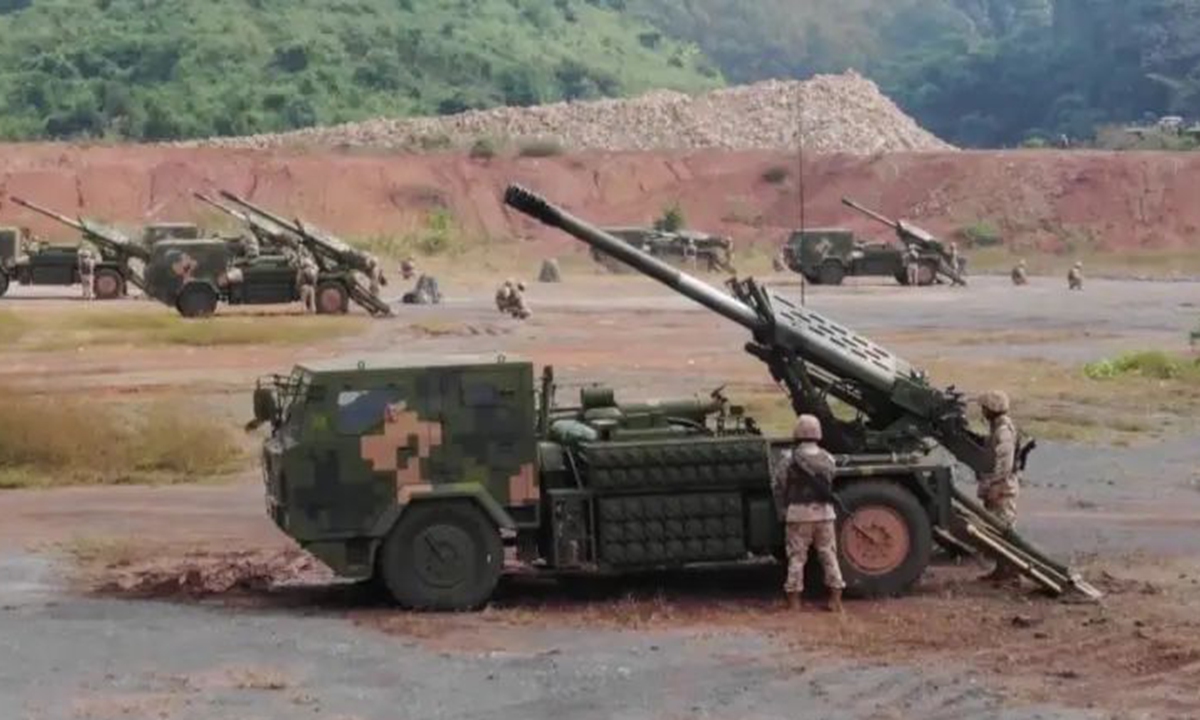
Vehicle-mounted howitzers affiliated with the army of the Chinese People's Liberation Army Southern Theater Command stand ready to fire during a three-day combat exercise on the Chinese side of the China-Myanmar border starting November 25, 2023. Photo: Screenshot from China Central Television
The Chinese People's Liberation Army (PLA) deployed howitzers and counter-battery radars in its ongoing live-fire exercise on the Chinese side of the China-Myanmar border in a move to test and show the troops' combat capabilities in safeguarding national sovereignty and border stability amid an armed conflict in the neighboring country.
The PLA's weapons of choice are very efficient in the region full of mountains covered by forests, experts said on Monday.
According to an annual training schedule, the PLA Southern Theater Command organized its army troops and launched a three-day combat exercise on the Chinese side of the China-Myanmar border starting Saturday in a move to test the troops' capabilities including fast maneuvering, border blockading and fire strike, China Central Television (CCTV) reported on Monday.
During the drills, the participating forces maneuvered rapidly to destinations and held live-fire exercises in different areas, different directions and different time periods under the coordinated command of the Southern Theater Command, as they carried out the combat exercise in a systematic and coordinated manner in groups.
Multiple strike groups launched precision strikes on randomly designated targets in multiple directions, while minesweeping and explosives disposal units cleared paths for armored assault units formed by wheeled infantry fighting vehicles to take positions.
The infantry fighting vehicles then deployed smoke screens to cover infantry soldier units that are ordered to attack randomly designated targets.
At the same time, multiple types of artilleries including vehicle-mounted rapid-fire guns and mortars were ordered to fire alternately to accurately hit targets hidden in mountains and forests.
The participating forces deployed vehicle-mounted counter-battery radars to accurately locate target positions, and the data were automatically distributed to firepower terminals of the artillery forces, guiding vehicle-mounted howitzer units to launch powerful suppressive fire on targets.
After several waves of fire strikes, the targets were accurately eliminated, CCTV reported.
The combat exercise simulated many scenarios, rapidly mobilized forces equipped with live weaponry from long distances, and was organized for several consecutive days, CCTV quoted a commanding officer of the exercise as saying.
"It focused on testing the troops' combat capabilities including fast maneuvering and fire strike, and displayed the PLA's resolute determination and ability to win in firmly defending national sovereignty, border stability as well as the safety of the people's lives and properties," said the officer, whose name was not mentioned in the report.
According to a notice released on the website of the government of Southwest China's Yunnan Province, the exercise is being held in three regions in the province, namely an area in the city of Mangshi, an area in the city of Ruili and an area in the county of Gengma.
The China-Myanmar border features mountainous terrains that are covered by forests even in early winter, which make target searching and precision strike challenging, a Chinese military expert who happened to visit two of the three exercise zones just a month ago told the Global Times on Monday, requesting anonymity.
The deployment of the combination of artilleries including vehicle-mounted howitzers and anti-battery radars enables the PLA to accurately locate potential threats and to immediately strike them down, the expert said, explaining that anti-battery radars are able to detect where hostile projectiles come from by reverse-calculating their trajectories.
Another highlight of the exercise is that almost all artilleries deployed in the drills are highly mobile, either man-portable or vehicle-mounted, so they are less likely to be on the receiving end of anti-battery radars from the opposing side, the expert said.
The PLA Southern Theater Command's exercise comes at a time when an armed conflict is intensifying in northern Myanmar close to the China-Myanmar border. The Chinese Embassy in Myanmar on Friday urged Chinese personnel to evacuate from the Laukkai area of the Kokang region, which is only about 5 kilometers away from the Chinese border.
Zhang Junshe, a Chinese military expert, told the Global Times that the exercise enhances the PLA's fast maneuvering capability that allows it to rapidly take positions and be ready for combat in case accidents take place along the border.
With the exercise for a border blockade, if foreign armed forces cross the border, the PLA can lock down the region immediately and control the situation, ensuring the border's stability on the Chinese side and the safety of the people's lives and properties, Zhang said.
Training fire strike means that the PLA is able to strike hostile armed forces that dare to trespass into Chinese territory, so the exercise also serves as a deterrence that warns related parties, Zhang said.




